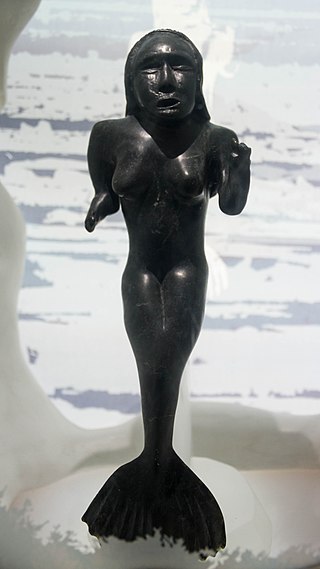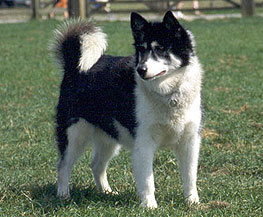Related Research Articles

Inuit religion is the shared spiritual beliefs and practices of the Inuit, an indigenous people from Alaska, northern Canada, parts of Siberia and Greenland. Their religion shares many similarities with some Alaska Native religions. Traditional Inuit religious practices include animism and shamanism, in which spiritual healers mediate with spirits. Today many Inuit follow Christianity, but traditional Inuit spirituality continues as part of a living, oral tradition and part of contemporary Inuit society. Inuit who balance indigenous and Christian theology practice religious syncretism.

In Aztec mythology, Xolotl was a god of fire and lightning. He was commonly depicted as a dog-headed man and was a soul-guide for the dead. He was also god of twins, monsters, misfortune, sickness, and deformities. Xolotl is the canine brother and twin of Quetzalcoatl, the pair being sons of the virgin Chimalma. He is the dark personification of Venus, the evening star, and was associated with heavenly fire. The Axolotl is named after him.
In Inuit mythology, an inua is a spirit or soul that exists in all people, animals, lakes, mountains, and plants. This is not an individual soul, but rather "the vital force representing a chain or continuum of all the individual spirits of that genus which had lived, were living, or were to live."

Sedna is the goddess of the sea and marine animals in Inuit mythology, also known as the Mother of the Sea or Mistress of the Sea. The story of Sedna, which is a creation myth, describes how she came to rule over Adlivun, the Inuit underworld.
In Inuit religion, Pinga is a goddess of the hunt and medicine. She is heavily associated with the sky.
In Inuit religion, Silap Inua or Silla is similar to mana or ether, the primary component of everything that exists; it is also the breath of life and the method of locomotion for any movement or change. Silla was believed to control everything that goes on in one's life.
The Adlet are a race of creatures in the Inuit mythology of Greenland, as well as the Labrador and Hudson Bay coasts. While the word refers to inland native American tribes, it also denotes a humanoid dog-legged tribe. The lower part of the body of the canine Adlet is like that of a dog and their upper part is like a man's. All Adlet run quickly, and their encounters with men usually end with man as the victor.

The Second Jungle Book is a sequel to The Jungle Book by Rudyard Kipling. First published in 1895, it features five stories about Mowgli and three unrelated stories, all but one set in India, most of which Kipling wrote while living in Vermont. All of the stories were previously published in magazines in 1894–5, often under different titles. The 1994 film The Jungle Book used it as a source.

The Xoloitzcuintle is one of several breeds of hairless dog. It is found in standard, intermediate, and miniature sizes. The Xolo also comes in a coated variety, totally covered in fur. Coated and hairless can be born in the same litter as a result of the same combination of genes. The hairless variant is known as the Perro pelón mexicano or Mexican hairless dog. It is characterized by its duality, wrinkles, and dental abnormalities, along with a primitive temper. In Nahuatl, from which its name originates, it is xōlōitzcuintli[ʃoːloːit͡sˈkʷint͡ɬi] (singular) and xōlōitzcuintin[ʃoːloːit͡sˈkʷintin] (plural). The name comes from the god Xolotl that, according to ancient narratives, is its creator and itzcuīntli[it͡sˈkʷiːnt͡ɬi], meaning 'dog' in the Nahuatl language.

Rudyard Kipling's The Jungle Book, also known as The Jungle Book, is a 1994 American adventure film co-written and directed by Stephen Sommers, produced by Edward S. Feldman and Raju Patel, from a story by Ronald Yanover and Mark Geldman. It is a live-action adaptation of the Mowgli stories from The Jungle Book (1894) and The Second Jungle Book (1895) by Rudyard Kipling, alongside Walt Disney's animated film of the same name from 1967.

The Inuit angakkuq is an intellectual and spiritual figure in Inuit culture who corresponds to a medicine man. Other cultures, including Alaska Natives, have traditionally had similar spiritual mediators, although the Alaska Native religion has many forms and variants.

The black dog is a supernatural, spectral, or demonic entity originating from English folklore that has also been seen throughout Europe and the Americas. It is usually unnaturally large with glowing red or yellow eyes, is often connected with the Devil, and is sometimes an omen of death. It is sometimes associated with electrical storms, and also with crossroads, barrows, places of execution and ancient pathways.

Inuit are a group of culturally similar indigenous peoples inhabiting the Arctic and subarctic regions of Greenland, Labrador, Quebec, Nunavut, the Northwest Territories, and Alaska. Inuit languages are part of the Eskimo–Aleut languages, also known as Inuit-Yupik-Unangan, and also as Eskaleut. Inuit Sign Language is a critically endangered language isolate used in Nunavut.

Dogs have played a role in the religion, myths, tales, and legends of many cultures.

Native American dogs, or Pre-Columbian dogs, were dogs living with people indigenous to the Americas. Arriving about 10,000 years ago alongside Paleoindians, today they make up a fraction of dog breeds that range from the Alaskan Malamute to the Peruvian Hairless Dog.
"In the Neolithic Age" is a poem by the English writer Rudyard Kipling. It was published in the December 1892 issue of The Idler and in 1896 in his poetry collection The Seven Seas. The poem is the source of the quotation: "There are nine and sixty ways of constructing tribal lays, / And every single one of them is right."
Idlirvirissong, or Irdlirvirisissong, is an evil spirit in the religion of the Inuit of Baffin Island and the Greenlandic Inuit.
The Goose Wife is a mythical female character that appears in tales from the Inuit and other ethnic groups that dwell across the circumpolar Arctic region. The usual story is that the geese alight on land, become women by taking off their goose-skins and bathe in a lake. However, they are unaware that a human hunter is spying on them, and he steals the goose-skin of one of them, forcing her to be his wife. Due to the great similarities between both characters, the goose wife has been compared to the swan maiden, another female that alternates between human and bird forms.
References
- ↑ Powell, J. W. (1888). Annual report of the Bureau of Ethnology to the Secretary, v.6. pp. 597, 603.
- ↑ Guirand, Félix (1935). The Larousse Encyclopedia of Mythology. p. 436.
- ↑ Merkur, Daniel (1991). Powers which We Do Not Know: The Gods and Spirits of the Inuit. p. 245.
- ↑ Kipling, Rudyard (November 1895). The Second Jungle Book.